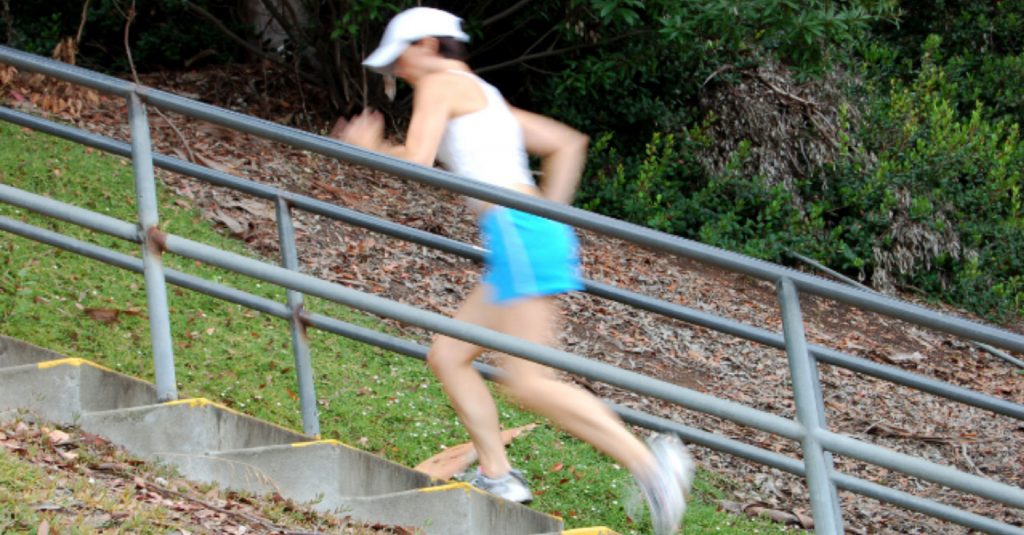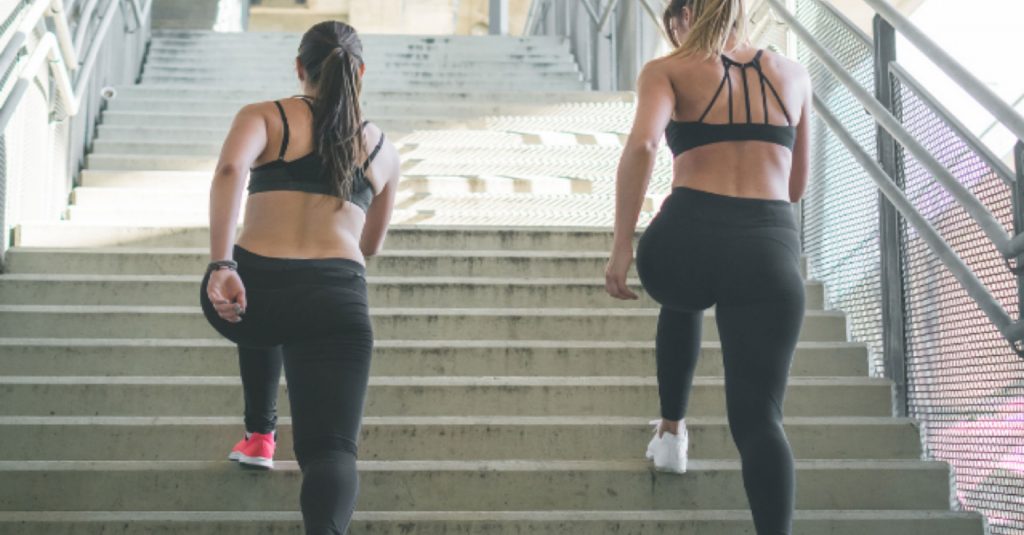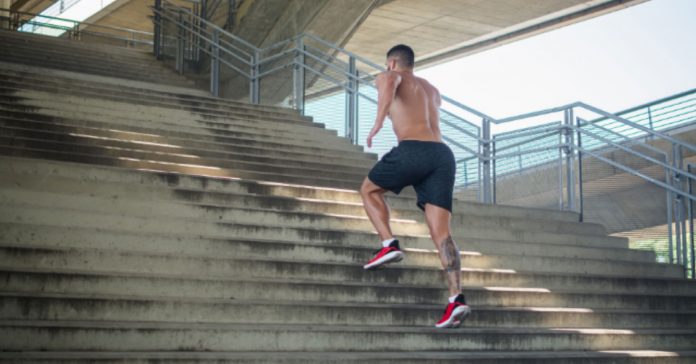We’ve all tried climbing stairs. And, you surely know that going up those steps gets your heart rate up more than just walking, even at the same distance.
But, ever wondered why climbing stairs is harder?
First, you are going against gravity.
Second, you have to carry your whole body weight on one leg, at least momentarily.
Since you have to overcome the resistance (gravity and body weight), you are using more muscles when climbing a staircase. Using more muscles requires more blood flow and oxygen supply. Thus, you tend to become winded and have your heart beating fast at the top landing.
Walking or running up a flight of stairs works your lower body, namely your quads, hamstrings, glutes, and calves. And as mentioned, it exercises the most important muscle of all, too — the heart. This is why stair climbing is great for both cardio and strength training.
But, simply pacing up the steps can be boring or too easy. This is why I am giving you 6 ways to make stair climbing more effective as a workout.
1. Stair Sprints
This is as basic as a stair workout gets.
You will simply be running up the stairs as quickly as you can. Then, walk back down for recovery. As soon as you hit the bottom landing, it’s time to run up again. Since stairs will vary in the total number of steps, use a timer instead to give you a training parameter for how much work you should do.
Go no less than 20 minutes to really work those legs. The key here is to not skip steps. What we want to train here is speed and coordination. This will help you improve footwork, especially for aspiring athletes.

2. Whole Body Stair Workout
Although stair climbing works the legs, we will use the platform or the landing of the stairs to work the upper body.
Run up a flight of stairs. You can choose to skip steps to make it harder. Then, upon reaching a landing, perform an upper-body bodyweight exercise like push-ups. Afterward, run to the next platform and do another upper body exercise again.
For the upper body exercises, go for failure. Even better, aim to push yourself beyond failure by incorporating mechanical drop sets. For example, after going to failure on decline push-ups, go for failure on regular push-ups. Then do knee push-ups after that.
This workout will help you build muscle mass everywhere in just one workout.
And, if you really push yourself enough, you should at least have a high-carb and high-protein meal beforehand. You can opt to buy a mass gainer if you want to have something quick and easy to consume before your workout.
3. Leg Power and Mass Builder
This workout helps you develop explosive power and really adds muscle mass to your legs. And, the rule is simple: skip steps.
You can skip one, two, or three steps. It depends on how long your limbs are or how far you can skip across steps. Do not overestimate your abilities; the last thing you’d want is the workout ending prematurely because you misstepped and suffered an injury.
Skipping steps puts your leg muscles under more strain, therefore, working them harder. The quicker and longer you skip, the more power is developed. This is because you are taking advantage of your muscles’ elasticity and training the speed and force of their contractions.
The longer you take for each step — specifically, the longer you bear your weight on one leg — the more muscle you build. This is because it’s under mechanical tension longer. And, mechanical tension is a primary factor for muscular hypertrophy.
BUT, this workout isn’t the only thing it takes to build bigger legs. You also have to incorporate different exercises, and even proper nutrition, into your program.

4. Timed Workout
Nothing will get your heart pumping more than having to race against time. Make sure you have a timer and any of the two devices: a step counter or calorie counter.
Determine two parameters you want to set for yourself:
- How many steps or calories you should burn, and
- How much time you are going to give yourself to step or burn that many.
Then, press “start” on the countdown and just go up and down the stairs non-stop until the time runs out. Estimating the time and steps or calories is important to maximize the workout.
For example, if you want to lose body fat, set your workout parameters to increase your heart rate the whole time. This will help you burn more calories. If you’re trying to build mass and are doing stair cardio as a form of active recovery, set the parameters so that you are going at an easy pace.
Active recovery speeds up the muscle-building process. To help with that, you can try using weight gain supplements to bolster your weight gain efforts.
5. Pyramid Runs
This workout involves short bursts of speed that get longer gradually. It’s great for training speed and anaerobic fitness.
You can divide the staircase using markers, or use the landings if it’s a long set of stairs. Run up to the nearest marker, and walk down. Then, run up to the second marker, and walk back down to the base.
If you are familiar with shuttle runs, then this is almost the same. The caveat is, once you reach the top-most marker, you’re not yet done. The next is to do everything in reverse: run to the top-most and down, then second to the top and down, and so on.
This will burn a ton of calories. So, if you can, have a meal high in carbs and protein before the workout. You will need enough fuel to work out and protect your muscle mass from being burned for fuel as well.

6. Skater Steps
They are called skater steps because the movement you’ll be doing mimics the side to side stride of ice skaters.
But, instead of strides, you’ll need to jump laterally. So, make sure you have wide enough steps for the workout. Besides moving alternately from right to left, you will also be skipping steps so you are forced to engage the muscles to produce enough leg drive.
This exercise improves muscular strength and neuromuscular coordination. Therefore, it develops agility and the ability to transfer weight from one leg to the other. Both of which are important skills for success in athletic endeavors.
Plus, it improves ankle, knee, and hip stability to increase balance and proprioception, and also helps avoid sports injuries from happening. Absorbing the impact of each landing also activates the core so you don’t fall over.
Skater steps have a cardio and resistance training element to them. Thus, it is a great leg builder and fat burner.
Staying Safe on the Stairs
First, always plant your entire foot on each step. Make sure every movement is initiated on a solid base, the heel, ball, and toes all planted. This way, you are less likely to trip, especially when starting a skip or jump.
Next, be careful of the nosing of each step (the hanging part). Be aware of these so you do not get your shoe toe caught, causing you to trip or fall over. It’s always best to wear properly fitted shoes no matter what workout you plan to do.
Lastly, use the handrails if you need to. If you are new to stair workouts, use them for support and balance, especially if you are going to push yourself hard.

Final Thoughts
You can get a workout anywhere if you’re creative enough — including the stairs.
Use this often taken-for-granted part of your house, apartment complex, school, or park to achieve your fitness goals. Stair climbing is more challenging, safer on the joints, and even helps you build those leg muscles. Who knew that this simple structure is functional in a bunch of different ways?
So, what are you waiting for? Take a step closer to your fitness goals, and give these workouts a try now!
About the author:



